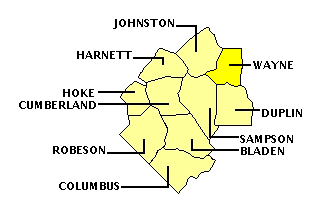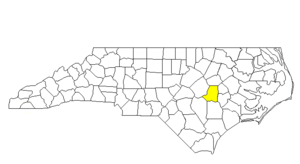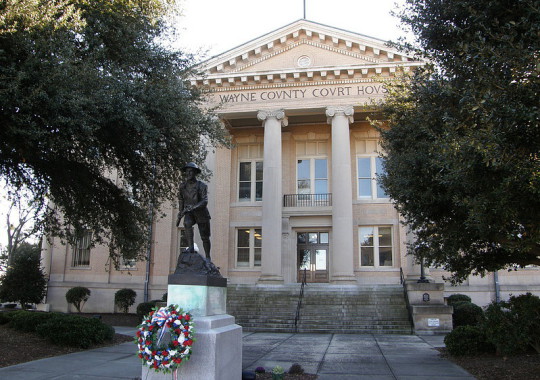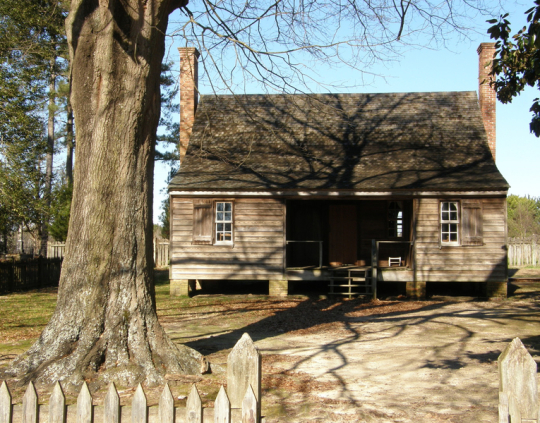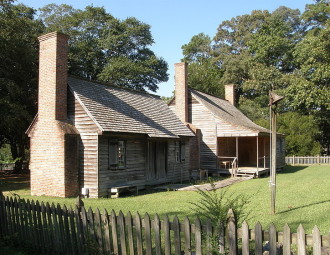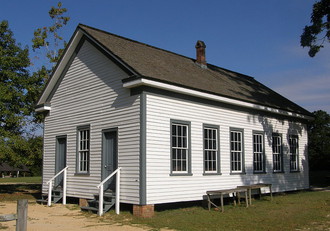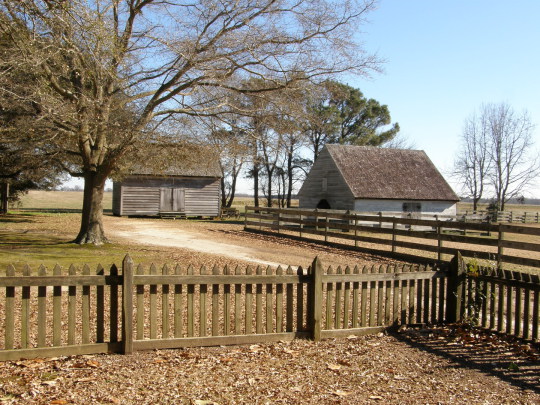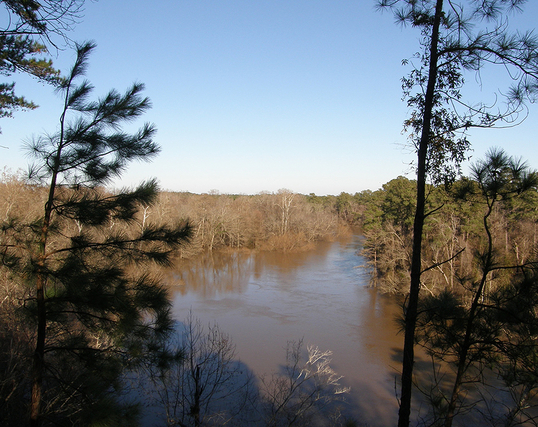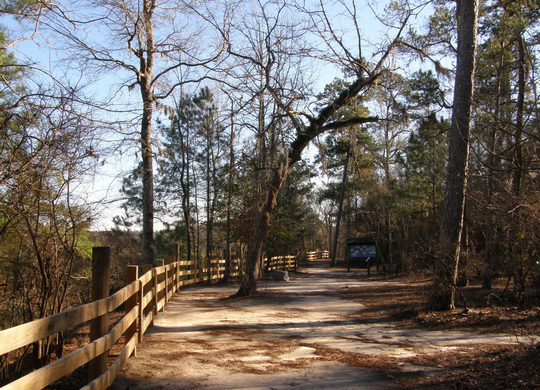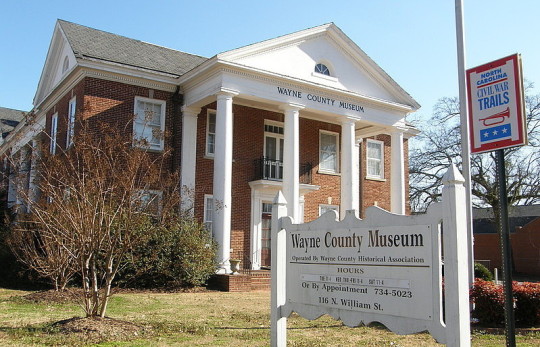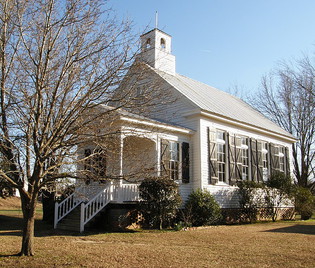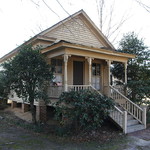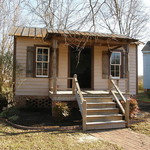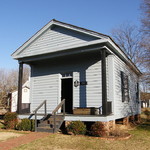WAYNE COUNTY
Scroll down this page or click on specific site name to view features on the following Wayne County attractions/points of interest:
Charles B. Aycock Birthplace State Historic Site, Cliffs of the Neuse State Park, Wayne County Museum, Waynesborough Historical Village
Fast facts about Wayne County:
Created in 1779, the county is named for Anthony Wayne, an American general in the Revolutionary War.
The county seat is Goldsboro, named for Matthew Goldsborough, an assistant engineer on the Wilmington & Weldon Railroad. Other communities include Dobbersville, Dudley, Mount Olive, Pikeville, Seven Springs, and Walnut Creek.
Wayne County’s land area is 552.57 square miles; the population in the 2010 census was 122,623.
It is noteworthy that Seymour Johnson Air Force Base is located on the outskirts of Goldsboro.
Below: Wayne County Courthouse, Goldsboro
Pikeville
The Charles B. Aycock Birthplace not only honors the individual who earned a reputation as North Carolina’s “education governor” but also gives visitors a look at a typical 19th century family farm and offers a glimpse of early 20th century schooling in the state. Charles Brantley Aycock was born November 1, 1859, the tenth and last child born to Benjamin and Serena Aycock. Financially, the family was well off – Benjamin owned 1,000 acres of good farmland and 13 slaves to help work it. As members of the Primitive Baptist Church, however, the Aycocks chose to live a simple lifestyle in a very unassuming frame house. Charles Aycock received his early schooling in Fremont and Kinston before attending the University of North Carolina for four years, graduating in 1880. The following year, he began a law practice. Almost immediately, he began a career in public service that continued throughout his life.
Aycock became the Democratic Party’s nominee for state governor in 1900, and his campaign championed the theme of white supremacy. Upon election, however, Governor Aycock worked tirelessly for much-needed improvements to the educational system across the state. His efforts bettered schools for all children, black and white alike. During Aycock’s term of office, local taxes and state funds helped build and equip more than 1,000 new school buildings statewide. Under the governor’s impetus, North Carolina’s “Educational Awakening” led to consolidated school districts that reduced wasteful spending, increased teachers’ pay, higher teacher requirements, and lengthened school terms. Although schools remained segregated, enrollment and attendance for both white and black students increased, while illiteracy for both groups decreased.
Interest in establishing a mem-orial to Governor Aycock began in the 1930s, but meaningful steps to do so were not actually taken until 1949. In the late 1950s, the state acquired original buildings and property from family descendants. The state mem-orial was dedicated November 1, 1959 the 100th anniversary of Aycock’s birth. The site includes the restored farmhouse, a replica kitchen, several refurbished dependencies, and the family cemetery; the governor himself is buried at Oakwood Cemetery in Raleigh. The visitor center includes interpretive exhibits and an audio-visual program about the life and times of Governor Aycock. Since the mid-1980s, the site has taken on the appearance of a typical family farm, circa 1870, and the staff is responsible for cultivating a variety of crops, a vegetable garden, and a small orchard, as well as raising sheep and chickens.
The memorial also includes the Oak Plain School, a one-room schoolhouse moved to the site in 1961 from a nearby community. The frame structure is repre-sentative of rural school buildings found throughout the state during Aycock’s time in office. Class-rooms typically were divided, with boys sitting on one side, girls on the other. Blackboards in such schoolhouses were literally boards painted black. To get to the site from Goldsboro, take US 117 North about 11 miles. The Aycock Birthplace is one mile north of Pikeville, on the right. Hours are 9-5 Tuesday through Saturday. Admission is free. 919-242-5581
Southeast of Goldsboro
Cliffs of the Neuse State Park is one of the North Carolina’s most diverse recreational areas in terms of the activities it offers. The site takes its name from the multi-colored, 90-foot cliffs that overlook a bend of the Neuse River in southeastern Wayne County. In eons past, the river eroded the soft rock along its western bank, uncovering layers of shale, sand, seashells and clay. The ribbons of yellow, tan, brown, and white that sparkle in the sunlight are a colorful record of the region’s geological history. The Tuscarora and Saponi Indian tribes that once inhabited the area considered the cliffs to be sacred ground, and the natives used the site for religious ceremonies and as a gathering spot before hunting expeditions. Thomas Hariot and Captain Arthur Barlowe, members of Sir Walter Raleigh’s 16th century expeditions, were early explorers to the region. Centuries later, the nearby town of Whitehall (today’s Seven Springs) was a popular health resort. Natural springs reputedly yielded mineral waters with various healing properties. Visitors to the town would take riverboat excursions to the cliffs as part of their weekend stay at one of Whitehall’s many hotels.
In 1945, the efforts of N. C. native Lionel Weil led to the establishment of a state park, with land along the west bank of the Neuse donated for that purpose by Weil and other individuals. Subsequently, another tract of land on the east bank was given to the state. Later donations and purchases increased the park to its current 748 acres. While the impressive cliffs might be the park’s most identifying feature, the diversity of plant and animal life within its borders is highly distinctive. Cypress and oaks typical of the coastal plain mingle with pines normally found in the Sandhills region and red oaks and Virginia pines more common in the western elevations. Spanish moss abounds. While the park has much to attract visitors year-round – strolls among flowering dogwoods and galax in spring, spectacular views of colorful foliage in autumn, peaceful walks in winter – summer naturally offers the widest variety of activities. An 11-acre man-made lake has all the amenities – a sandy beach, a diving platform, modern bathhouse facilities, and even a refreshment stand. Rowboats are also available for rent. Fishing is another popular activity, and the Neuse River yields bluegill, catfish, largemouth bass, and, in the spring, shad. The park also features a large picnic area with grills and restroom facilities; campgrounds; and a small nature museum with interpretive exhibits focusing on the geological and natural history of the area. From Goldsboro, take NC 111 South for 14 miles. The park opens 8:00 AM year-round; closing hours vary seasonally. The campground is open from mid-March through November. The Natural History Museum is open 1-5 daily mid-March through November, and weekends only during the winter months.
Goldsboro
The Wayne County Museum in Goldsboro presents an overview of the history and people of this eastern North Carolina county. The house in which the Museum is located has an interesting history of its own. Built in 1927 to be the home of the Goldsboro Women's Club, over the years it has also served as a USO facility, a charm school, and even, for a brief period, a department store. Since 1988, however, it has been the exclusive home of the county museum. Along with many items of furniture from area families dating to the late 19th and early 20th centuries, there are exhibits dealing with early settlement, the USO, and the military. Included in the latter is information about Revolutionary War General Anthony Wayne, for whom the county is named, and a diorama depicting the Civil War battle for Goldsborough Bridge. One section of the Museum spotlights dozens of noteworthy county residents and families who have made a positive impact upon the community.
Goldsboro
Waynesborough Historical Village is a representation of the settlement that served as the seat of government for Wayne County during the first half of the 1800s. The Village is located on Elm Street in Goldsboro. Realtors will tell you its location, location, location, and so it was with Waynesborough, former seat of government for Wayne County in eastern North Carolina. The county was formed in 1779, and the little community of Waynesborough, located along the banks of the Neuse River, was a natural site for the county seat, and a courthouse and jail were built in 1784. With traffic and trade from the river, and connected by stage routes to Raleigh, Fayetteville, New Bern, and Tarborough, the settlement blossomed. In 1839, however, the Wilmington-Weldon railroad line bypassed the town, with tracks laid about a mile-and-a-half to the east. Shortly thereafter, at the place where railroad lines running east-west crossed the Wilmington-Weldon line, a new town sprang up. Named for Matthew T. Goldsborough, who supervised construction of the railroad, the community of Goldsborough Junction soon lured businesses and residents away from Waynesborough. When steamship business on the river ceased, the older town was further crippled. The town all but ended when a public vote in 1847 officially made Goldsborough the county seat. In the final month of the Civil War, Union troops under General Sherman burned all that remained of Waynesborough.
In the 1980s the Old Waynesborough Commission was formed to create a village near the site of the original county seat. Over the past two decades, a number of buildings have been moved to the park, and visitors today, with a little imagination, can step back into an earlier time. In all, there are over a dozen structures, including homes, schools, churches, and offices. Although none of the buildings are original to the town of Waynesborough, all are representative of a part of the county’s history, and most date from the early to late 19th century.
Perhaps the most imposing building is also the newest. The Park Hill School was constructed in 1911 and is typical of rural schools in Wayne County and across the state at the turn of the 20thcentury. The Grand Lodge of the International Order of Odd Fellows oversaw the relocation and refurbishing of the schoolhouse and currently uses the building as a state lodge. Another interesting structure is the medical office, circa 1870, of Dr. John Bryan Kennedy. In addition to serving his community as a family practitioner, in his youth Kennedy had a distinguished career fighting for the Confederacy. A veteran of Manassas, Seven Days, the Wilderness, and Fort Fisher, he was one of Jefferson Davis’ bodyguards when the Confederate president sought escape from the Union dragnet in 1865.
Among the other buildings are the law office of attorney William T. Faircloth, who served the state as an associate justice on the North Carolina Supreme Court; the Bethany Meeting House, used by Quakers from 1878 to 1953; the Wiggins House, circa 1850, a simple one-room frame house that was home to James and Louise Wiggins; and the general store, built in the 1890s. Two other schoolhouses, a new blacksmith shop, and a variety of barns help round out the village. The Wayne County Visitors Center and Waynesborough Historical Village is off US 117 Bypass. Turn left onto Elm Street to access the parking area. Hours are 10-4 Monday-Saturday and 1-4 Sunday. Admission is free. Several special event days are held during the year, and a local blacksmith works his trade on alternating weekends. 919-731-1653
Wayne County is bordered by DUPLIN, GREENE (Region Two), JOHNSTON, LENOIR (Region Three), SAMPSON, and WILSON (Region Two) counties.
Return to REGION FIVE HOME PAGE.
Return to GEOGRAPHIC REGIONS HOME PAGE.

